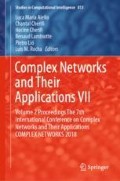Abstract
We perform a first-of-its-kind characterization of topical homophily - familiarity co-occurring with topic-participation similarity of user pairs - by correlating topic participation similarity and degree of familiarity of users on Twitter. We quantify similarity between a user pair by measuring their distribution of participation in topics, wherein topics are defined as clusters of hashtags formed using semantically related user-generated content. We examine the topic participation similarity of users against different degrees of familiarity: edges, shared neighbors, and structural communities. We provide varying relaxation in identifying topics, and characterize the correlation of topical similarity with the degree of familiarity over the range of relaxation. We empirically substantiate the characteristics of topical homophily, over the varying relaxation of identified topics. We empirically show that homophily grows linearly with increase of familiarity, reaches a peak, and subsequently falls, indicating that, familiarity correlates with similarity up to a point, beyond which, similarity occurs for other reasons.
Access this chapter
Tax calculation will be finalised at checkout
Purchases are for personal use only
References
Allen, J.F.: Maintaining knowledge about temporal intervals. Commun. ACM 26(11), 832–843 (1983)
Aral, S., Muchnik, L., Sundararajan, A.: Distinguishing influence-based contagion from homophily-driven diffusion in dynamic networks. PNAS 106(51), 21,544–21,549 (2009)
Cunha, E., Magno, G., Comarela, G., Almeida, V., Gonçalves, M.A., Benevenuto, F.: Analyzing the dynamic evolution of hashtags on twitter: a language-based approach. In: Languages in Social Media. ACL (2011)
De Choudhury, M., Sundaram, H., John, A., Seligmann, D.D., Kelliher, A.: “birds of a feather”: does user homophily impact information diffusion in social media? (2010). arXiv:1006.1702
Dey, K., Kaushik, S., Garg, K., Shrivastava, R.: Topic lifecycle on social networks: analyzing the effects of semantic continuity and social communities. In: ECIR. Springer (2018)
Dey, K., Shrivastava, R., Kaushik, S., Mathur, V.: Assessing the effects of social familiarity and stance similarity in interaction dynamics. In: International Conference on Complex Networks, pp. 843–855. Springer (2017)
Halberstam, Y., Knight, B.: Homophily, group size, and the diffusion of political information in social networks: evidence from twitter. J. Public Econ. 143 (2016)
Ifrim, G., Shi, B., Brigadir, I.: Event detection in twitter using aggressive filtering and hierarchical tweet clustering. In: SNOW-DC@ WWW, pp. 33–40 (2014)
Mathioudakis, M., Koudas, N.: Twittermonitor: trend detection over the twitter stream. In: SIGMOD, pp. 1155–1158. ACM (2010)
McPherson, M., Smith-Lovin, L., Cook, J.M.: Birds of a feather: homophily in social networks. Annu. Rev. Sociol. 27(1) (2001)
Newman, M.E.: Modularity and community structure in networks. PNAS 103(23), 8577–8582 (2006)
Šćepanović, S., Mishkovski, I., Gonçalves, B., Nguyen, T.H., Hui, P.: Semantic homophily in online communication: evidence from twitter. Online Soc. Netw. Media 2, 1–18 (2017)
Stieglitz, S., Dang-Xuan, L.: Emotions and information diffusion in social media - sentiment of microblogs and sharing behavior. J. Manag. Inf. Syst. 29(4), 217–248 (2013)
Author information
Authors and Affiliations
Corresponding author
Editor information
Editors and Affiliations
Rights and permissions
Copyright information
© 2019 Springer Nature Switzerland AG
About this paper
Cite this paper
Dey, K., Shrivastava, R., Kaushik, S., Garg, K. (2019). Assessing Topical Homophily on Twitter. In: Aiello, L., Cherifi, C., Cherifi, H., Lambiotte, R., Lió, P., Rocha, L. (eds) Complex Networks and Their Applications VII. COMPLEX NETWORKS 2018. Studies in Computational Intelligence, vol 813. Springer, Cham. https://doi.org/10.1007/978-3-030-05414-4_29
Download citation
DOI: https://doi.org/10.1007/978-3-030-05414-4_29
Published:
Publisher Name: Springer, Cham
Print ISBN: 978-3-030-05413-7
Online ISBN: 978-3-030-05414-4
eBook Packages: Intelligent Technologies and RoboticsIntelligent Technologies and Robotics (R0)

